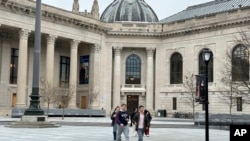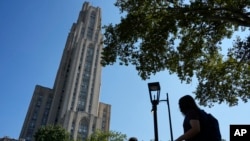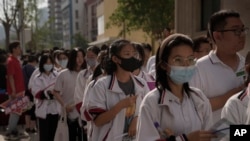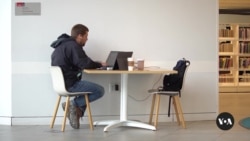Student Union
US Colleges Struggle to Balance COVID-19 With Classes

Colleges and universities are seeing an increase of cases of COVID-19 as students return to campus, with some seeing rapid increases while others are keeping a lid on the spread of disease.
Four sources are compiling information about colleges and COVID-19, including case-tracking maps: The New York Times, The Chronicle of Higher Education, Davidson College’s College Crisis Initiative (C2i), and Inside Higher Education.
So far, there is no unified national coordinated plan from higher education on how to handle the spread of the coronavirus on university campuses across the United States, say experts, including Lynn Pasquerella, president of the Association of Colleges and Universities (AAC&U), and Frederick M. Lawrence, former president of Brandeis University and CEO of the Phi Beta Kappa Society, in separate interviews with VOA.
Tracking COVID-19
In early August, before the fall semester started at many schools, nearly half (48%) of more than 1,275 colleges and universities planned for an in-person semester, while 35% proposed a hybrid model and 14% online, according to The Chronicle of Higher Education, which has been tracking colleges since spring 2020.
But as of October 1, only 4% of nearly 3,000 institutions were “fully in person” for the fall semester, 23% reported a “primarily in person” teaching situation, and 21% offered a hybrid of in-person and online courses for students. Thirty-four percent were “primarily online” with 10% fully online. Eight percent remained undecided or “other,” according to data from the Chronicle and Davidson.
Some of those closures came after students returned to campus or nearby, and COVID-19 cases spiked. James Madison University in Virginia halted in-person classes completely, and the University of Wisconsin-Madison saw an increase in cases that forced the school to enter a two-week lockdown.
State University of New York-Cortland, with 6,800 students, converted to all online classes October 6 after a spike in cases. At SUNY-Oneonta, nearly 700 students tested positive for COVID-19, and the university moved to online-only classes for the rest of the semester. SUNY-Oswego returned to in-person learning on October 5 after a two-week closure begun when more than 100 cases were confirmed on campus.
Most U.S. colleges and universities are not conducting widespread coronavirus tests despite the rise of cases on campuses, according to an NPR analysis.
Data of more than 1,400 colleges compiled by the College Crisis Initiative at Davidson and analyzed by NPR show that more than 2 in 3 colleges with in-person classes have no testing plan or are doing limited testing for only students at risk.
Universities with high numbers of COVID-19 cases and “no clear plan” include Virginia Polytechnic Institute and State University (29,300 undergraduate students enrolled), Troy University (12,995 undergraduate students enrolled) and Southeast Missouri State University (9,524 undergraduate students enrolled).
The University of Alabama has the highest average number of daily cases with 82.6 per 100,000 in the county containing the college. The university is conducting random surveillance testing, according to its website.
Student reactions
Despite measures to keep schools safe, many students and staff raised concerns before campuses reopened.
“So you’re telling me that we can't control the spread of covid between 42 people on campus during orientation, but we’re going to bring 20,000+ students to that same space in 3 weeks?? I want to be back @MissouriState. But we need more than a vague plan to get us there,” tweeted Jasmine Crawford from Missouri State University.
“Friday night in State College, PA. @GovernorTomWolf we need another lockdown. @pennstate you may be able to enforce social distancing on campus, but students in State College = students in bars. Take that into account,” tweeted Sage McKeand, an undergraduate student at Penn State University.
In June, more than half of 7,234 Purdue University faculty and staff reported they “felt unsafe about returning to campus for a fall semester with in-person classes,” according to The Indianapolis Star.
Over 90% said they were “not confident students would ‘socially distance appropriately outside the classroom (e.g., on weekends, at bars and parties).’ ”
Sherry Pagoto, a clinical psychologist at the University of Connecticut, surveyed college students about returning to campus in July, and found that the students that responded to their survey agreed that the required 14-day quarantine before the semester started was “not realistic” and “will likely fail.”
Pagoto and research assistant Laurie Groshon interviewed seven focus groups of four to seven students each.
Students said they were “pessimistic” about wearing masks during social events, although they said it would depend on the “social norms” of groups and stated they were unsure about how to hold one another accountable.
Students also stated that the threshold for closing campuses should be “based on several weeks of increasing cases on campus and should not wait until someone dies.”
The status quo
The University of Alabama (UA) and the University of Georgia (UGA) have the most cases, according to a New York Times case tracker. As of September 25, 2,690 confirmed cases had been reported at UA and 3,532 confirmed cases had been reported at UGA.
Some students say their universities have not been careful with containing cases.
At UGA, Max Appelbaum, a fourth-year atmospheric sciences major from Trion, Georgia, lives in off-campus housing with two roommates. He is taking two online classes and two in-person classes.
Appelbaum said in a message to VOA that he was “disgusted” and that it was “incredibly irresponsible to come back to campus at all.”
“Basically, the administration isn't listening to its own researchers who are studying coronavirus and are telling them that their plan is inadequate and that it was not safe to reopen campus,” he messaged VOA.
Greg Trevor, executive director for marketing and communications at UGA, disagreed.
Trevor said the university consulted many health experts before deciding to resume in-person classes. The health experts included a medical oversight task force, composed of the dean of the College of Public Health, the executive director of the University Health Center and the campus dean of the Augusta University/UGA Medical Partnership.
"From the outset of the pandemic, the University of Georgia’s primary commitment has been to the health and safety of our faculty, staff and students. We worked diligently — with the engagement of faculty health and medical experts — to prepare our campus for the resumption of in-person instruction this fall in a manner consistent with federal and state health and safety guidelines,” he wrote in an email to VOA.
Other large universities have had a relatively small number of coronavirus cases.
California State University-Fullerton (CSUF) has had three cases among its 35,169 undergraduate students.
CSUF laid out a six-step plan for readmitting students to campus and ensuring the safety of faculty and students. The plan is now in its third phase, according to its coronavirus website.
“For those who will be on campus in the fall, it will be each person’s responsibility to adhere to all safety protocols to reduce the risk of infection among our campus community members and their families. This includes using face masks, practicing good hygiene and maintaining social distance,” it wrote.
If anyone is exposed or comes in contact with someone exposed, this person “must remain off campus, self-quarantine, and follow all applicable public health orders,” it continued.
Crucial practices
The University of Wisconsin-Superior has had only one case of coronavirus out of its 2,259 undergraduate students and, according to Jordan Milan, director of strategic communications and special assistant to the chancellor, this case was not linked to the 54% of classes that are on campus.
“We recognize that the success of this model is dependent on our on-campus community engaging in social distancing, wearing a mask and keeping hands sanitized. We have reminders of these practices posted throughout campus,” she wrote in an email to VOA.
In addition to signs about social distancing and wearing masks on campus, there are three different flow charts of procedures that students should follow if they contract coronavirus living on campus, off campus or in a distance-learning environment.
As Milan mentioned, the spread of coronavirus on campuses depends on student behavior and whether they obey social distancing guidelines and other policies laid out by their universities.
Appelbaum noted that if he saw students disobeying rules UGA laid out, he would ask people to put their masks on and observe social distancing. “I just want to be as safe as I can be in a bad situation,” he said.
An earlier version of this article incorrectly included Michigan Technological University among institutions that do not have a clear plan to deal with the coronavirus.
See all News Updates of the Day
- By VOA News
Competition grows for international students eyeing Yale

It’s tough to gain admission to Yale University, and it’s getting even tougher for international students as standout students from around the world set their sights on Yale.
The Yale Dale News, the campus newspaper, takes a look at the situation here.
- By VOA News
Student from Ethiopia says Whitman College culture made it easy to settle in

Ruth Chane, a computer science major from Ethiopia, writes about her experiences settling into student life at Whitman College in the U.S. state of Washington.
"The community at Whitman College made sure I felt welcomed even before I stepped foot on campus," she says.
- By VOA News
Claremont Colleges student gets a shock when she heads home to Shanghai

In The Student Life, the student newspaper for the Claremont Colleges, a consortium of five liberal art colleges and two graduate schools in Claremont, California, student Rochelle Lu writes about readjusting to her Shanghai home after spending a semester in the United States.
- By VOA News
Cedarville University aims to ease transition for international students

Cedarville University in the U.S. state of Ohio says it’s got more than 140 international students representing 44 countries.
Here, the school interviews Jonathan Sutton, director of international student services. He talks about his job and the opportunities for international students on campus.
- By VOA News
Morehouse College offers prospective students tips on applying and thriving

Morehouse College, a private, historically Black liberal arts college in the U.S. state of Georgia, offers a guide for international students interested in attending the school.
Among the tips to apply and thrive at Morehouse:
- Take advantage of the school’s orientation program
- Turn to the school’s Center for Academic Success for tutoring, support and more
- Immerse yourself in campus life via clubs and societies
- By Reuters
US reviews Columbia University contracts, grants over antisemitism allegations

The administration of President Donald Trump said on Monday it will review Columbia University's federal contracts and grants over allegations of antisemitism, which it says the educational institution has shown inaction in tackling.
Rights advocates note rising antisemitism, Islamophobia and anti-Arab bias since U.S. ally Israel's devastating military assault on Gaza began after Palestinian Hamas militants' deadly October 2023 attack.
The Justice Department said a month ago it formed a task force to fight antisemitism. The U.S. Departments of Health and Education and the General Services Administration jointly made the review announcement on Monday.
"The Federal Government's Task Force to Combat Anti-Semitism is considering Stop Work Orders for $51.4 million in contracts between Columbia University and the Federal Government," the joint statement said.
The agencies said no contracting actions had been taken yet.
"The task force will also conduct a comprehensive review of the more than $5 billion in federal grant commitments to Columbia University."
The agencies did not respond to requests for comment on whether there were similar reviews over allegations of Islamophobia and anti-Arab bias.
Columbia had no immediate comment. It previously said it made efforts to tackle antisemitism.
College protests
Trump has signed an executive order to combat antisemitism and pledged to deport non-citizen college students and others who took part in pro-Palestinian protests.
Columbia was at the center of college protests in which demonstrators demanded an end to U.S. support for Israel due to the humanitarian crisis caused by Israel's assault on Gaza. There were allegations of antisemitism and Islamophobia in protests and counter-protests.
During last summer's demonstrations around the country, classes were canceled, some university administrators resigned and student protesters were suspended and arrested.
While the intensity of protests has decreased in recent months, there were some demonstrations last week in New York after the expulsion of two students at Columbia University-affiliated Barnard College and after New York Governor Kathy Hochul ordered the removal of a Palestinian studies job listing at Hunter College.
A third student at Barnard College has since been expelled, this one related to the occupation of the Hamilton Hall building at Columbia last year.
Canada’s immigration overhaul signals global shift in student migration
From Europe to North America, nations are tightening their immigration policies. Now Canada, long seen as one of the world's most welcoming nations, has introduced sweeping changes affecting international students. The reforms highlight a growing global trend toward more restrictive immigration policies. Arzouma Kompaore reports from Calgary.
Trump administration opens antisemitism inquiries at 5 colleges, including Columbia and Berkeley

The Trump administration is opening new investigations into allegations of antisemitism at five U.S. universities including Columbia and the University of California, Berkeley, the Education Department announced Monday.
It's part of President Donald Trump's promise to take a tougher stance against campus antisemitism and deal out harsher penalties than the Biden administration, which settled a flurry of cases with universities in its final weeks. It comes the same day the Justice Department announced a new task force to root out antisemitism on college campuses.
In an order signed last week, Trump called for aggressive action to fight anti-Jewish bias on campuses, including the deportation of foreign students who have participated in pro-Palestinian protests.
Along with Columbia and Berkeley, the department is now investigating the University of Minnesota, Northwestern University and Portland State University. The cases were opened using the department's power to launch its own civil rights reviews, unlike the majority of investigations, which stem from complaints.
Messages seeking comment were left with all five universities.
A statement from the Education Department criticized colleges for tolerating antisemitism after Hamas' Oct. 7, 2023, attack on Israel and a wave of pro-Palestinian protests that followed. It also criticized the Biden administration for negotiating "toothless" resolutions that failed to hold schools accountable.
"Today, the Department is putting universities, colleges, and K-12 schools on notice: this administration will not tolerate continued institutional indifference to the wellbeing of Jewish students on American campuses," said Craig Trainor, the agency's acting assistant secretary for civil rights.
The department didn't provide details about the inquiries or how it decided which schools are being targeted. Presidents of Columbia and Northwestern were among those called to testify on Capitol Hill last year as Republicans sought accountability for allegations of antisemitism. The hearings contributed to the resignation of multiple university presidents, including Columbia's Minouche Shafik.
An October report from House Republicans accused Columbia of failing to punish pro-Palestinian students who took over a campus building, and it called Northwestern's negotiations with student protesters a "stunning capitulation."
House Republicans applauded the new investigations. Representative Tim Walberg, chair of the Education and Workforce Committee, said he was "glad that we finally have an administration who is taking action to protect Jewish students."
Trump's order also calls for a full review of antisemitism complaints filed with the Education Department since Oct. 7, 2023, including pending and resolved cases from the Biden administration. It encourages the Justice Department to take action to enforce civil rights laws.
Last week's order drew backlash from civil rights groups who said it violated First Amendment rights that protect political speech.
The new task force announced Monday includes the Justice and Education departments along with Health and Human Services.
"The Department takes seriously our responsibility to eradicate this hatred wherever it is found," said Leo Terrell, assistant attorney general for civil rights. "The Task Force to Combat Anti-Semitism is the first step in giving life to President Trump's renewed commitment to ending anti-Semitism in our schools."
- By VOA News
STEM, business top subjects for international students

The Times of India breaks down the most popular subjects for international students to study in the U.S.
STEM and business lead the pack. Read the full story here. (January 2025)
- By VOA News
Safety and visa difficulties among misconceptions about US colleges

U.S. News & World report addresses some of the misconceptions about U.S. colleges and universities, including the difficulty of getting a visa.
Read the full story here. (January 2025)
- By VOA News
Work opportunities help draw international students to US schools

US News & World Report details the three top factors in foreign students' decision to study in the U.S. They include research opportunities and the reputation of U.S. degrees. Read the full story here. (December 2024)
- By VOA News
British student talks about her culture shock in Ohio

A British student who did a year abroad at Bowling Green State University in Ohio talks about adjusting to life in America in a TikTok video, Newsweek magazine reports.
Among the biggest surprises? Portion sizes, jaywalking laws and dorm room beds.
Read the full story here. (December 2024)
- By VOA News
Harvard's Chan School tells international students what to expect

Harvard's T.H. Chan School of Public Health reaches out to international students by detailing the international student experience at the school.
Learn more about housing, life in Boston and more here.
- By Reuters
China unveils plan to build 'strong education nation' by 2035

China issued its first national action plan to build a "strong education nation" by 2035, which it said would help coordinate its education development, improve efficiencies in innovation and build a "strong country."
The plan, issued Sunday by the Communist Party's central committee and the State Council, aims to establish a "high quality education system" with accessibility and quality "among the best in the world."
The announcement was made after data on Friday showed China's population fell for a third consecutive year in 2024, with the number of deaths outpacing a slight increase in births, and experts cautioning that the downturn will worsen in the coming years.
High childcare and education costs have been a key factor for many young Chinese opting out of having children, at a time when many face uncertainty over their job prospects amid sluggish economic growth.
"By 2035, an education power will be built," the official Xinhua news agency said, adding that China would explore gradually expanding the scope of free education, increase "high-quality" undergraduate enrolment, expand postgraduate education, and raise the proportion of doctoral students.
The plan aims to promote "healthy growth and all-round development of students," making sure primary and secondary school students have at least two hours of physical activity daily, to effectively control the myopia, or nearsightedness, and obesity rates.
"Popularizing" mental health education and establishing a national student mental health monitoring and early warning system would also be implemented, it said.
It also aims to narrow the gap between urban and rural areas to improve the operating conditions of small-scale rural schools and improve the care system for children with disabilities and those belonging to agricultural migrant populations.
The plan also aims to steadily increase the supply of kindergarten places and the accessibility of preschool education.
- By VOA News
A look at financial aid options for international graduate students in US

The Open Notebook, a site focusing on educating journalists who cover science, has complied a list of U.S. graduate program financial aid information for international students.











